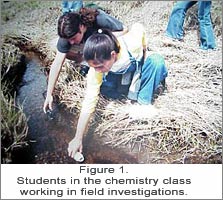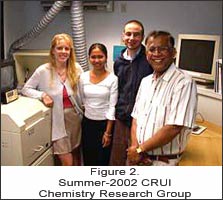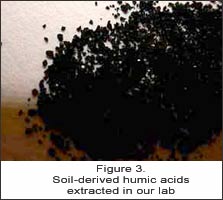Metals, Soils,
Pollution and Plasma Spectrochemistry
My research in analytical chemistry
involves the identification (What are they?) and quantification
(…then how much?) of chemical species. In addition,
I do investigations of fate and transport properties
of trace metals in soils, aquatic environments (see
Figure. 1), and biological materials. My students
and I use spectroscopic methods including inductively
coupled plasma -mass spectrometry (ICP-MS) and atomic
emission spectroscopy (ICP-AES) (see Figure.
2) for these investigations. Plasma spectrochemistry
is the hub of my research, and that radiates to an
intriguing array of interdisciplinary research questions
that involve analysis of environmental and biological
materials such as humic substances and children's
teeth.

Division III students in our
research group often present their work in national
and international scientific forums, and some have
published their work in peer reviewed journals and
edited books.
Metal Complexation Properties
of Humic Substances
Understanding and analyzing the chemical
and physical properties of humic substances is vitally
important in planning the clean-up of contaminated
sites and in developing effective soil remediation
programs (Figure 3). Humic substances are dark brown
organic macromolecules found in aquatic and soil environments.
They are important carbon reservoirs and thermal buffers
in subsurface soils so they play vital roles in determining
how well agricultural soils retain nutrients and how
long contaminated soils, sediments, and water retain
toxic trace metals.
For the past five years we have been
characterizing physical properties such as diffusion coefficient, molecular weights, sizes and
trace metal complexing properties of humic substances
using flow field-flow fractionation (flow FFF) and
high performance liquid chromatography (HPLC) methods.
In addition we have investigated the chemical functionality
of humic substances and how these substances affect
the metal (i.e., Al, Cu, Cd, Mn, Pb, Zn, Fe)
complexation properties of soils, composts, and sediments.
diffusion coefficient, molecular weights, sizes and
trace metal complexing properties of humic substances
using flow field-flow fractionation (flow FFF) and
high performance liquid chromatography (HPLC) methods.
In addition we have investigated the chemical functionality
of humic substances and how these substances affect
the metal (i.e., Al, Cu, Cd, Mn, Pb, Zn, Fe)
complexation properties of soils, composts, and sediments.
Trace Metal Distribution in Children's
Teeth
Enamel growth layers of teeth can
provide information about one's past nutritional status
and exposure to trace metals. Such information can
be an important health indicator in children. In collaboration
with Biological anthropologist, geologist, and a team
of Hampshire students, (Figure 2) we are examining
distribution of trace metals (Zn, Fe, Pb, Ca, and
Sr) in the enamel of deciduous teeth of children from
Solis Valley, Mexico. This work is supported by NSF
collaborative research in undergraduate institutions
(CRUI) grant.
Laser ablation is used to "scoop"
micro samples of enamel material from the teeth, and
presence of trace elements is determined by the ICP-MS
The investigation of the distribution
of trace metals in particular growth layers on the
teeth enamel indicates whether these substances were
deposited before or after birth (pre- and post-natal).
In addition we investigate lead in glazed ceramics
and measure lead isotope ratios in teeth using ICP-MS
to determine source origins of lead pollution.
Sample Preparation Methods for
Plasma Spectrochemical Trace Metal Analysis
Proper collection and preparation
of samples is critical to accurate analysis of trace
metals in environmental and biological material, but
it is also the Achilles heel or weakest link. It is
necessary to develop accurate and efficient sample
digestion methods. Novel sample preparation methods
have been developed in our lab for ICP-AES and MS
analysis of environmental and biological samples such
as syrups and breast milk.



